When I saw on twitter that my Twitter chum Julia Moore had:
Decided adding
#sourdough culture to some of our freshly pressed apples would be one experiment too far
I was intrigued and showed her my Bouza bread beer experiment post. Despite my references to ‘vomit’, Julia changed her mind and took up the challenge.
I’m so pleased Julia did this and her guest post below charts her progress. A second post will show how she used the remains from the cider fermentation to make a cider barm bread.
Julia says:
I hope this little experiment encourages someone else to have an idea and then just have a go 🙂
Precisely the attitude I promote on this blog! To find out more, please read on…
Making cider with sourdough
These are my first tender steps into the world of fermenting liquor, until now the main focus of my attention has been wild yeast bread baking. I am by no means a baker and definitely not a brewer. I’d most likely be described as ‘domestically challenged’, however I have become fascinated with the alchemy of sourdough. Over the past 18 months I have created several different cultures and have experimented with them in as many ways as time has allowed.
This is the result of my latest experiment to find out if I could use my Red Fife wholewheat wild yeast culture to ferment cider. See note below
The apples
We are very lucky to have 6 mature apple trees bordering our workshop on the edge of Greenham Common Newbury, and following a very successful visit to Newbury Ale & Cider Festival in September we felt compelled to put the free apple resource to good use. So, in the last week of November we hired an apple press and scratter then between myself, my husband and a friend we set about pressing 50 litres of apple juice in preparation for our first cider harvest.
The two 25 litre barrels would be treated very differently. Our friend took one of the barrels away, he killed off all the natural yeasts and bacterias then added champagne yeast and various amounts of sugar, I nearly cried when I heard what he’d done! We on the other hand had a 100% natural ferment planned for our 25 litres, nothing to be added and nothing taken away, we would just let nature take its course, and if we ended up with 25 litres of cider vinegar then so be it.
It took 6 days before the juice in our 25 litre barrel began to ferment and it was during this time that I began to wonder if I might be able to use the wild yeasts in my sourdough culture to seed some of my own cider.
The experiment
Equipment
I had everything I needed at hand to start an experiment; two empty 1 litre glass bottles, a domestic juicer, a box of apples and sourdough culture.
Method
Mix and ferment a small amount of sourdough culture for 8hrs with fresh pressed apple juice and flour..
5g wholewheat culture + 10g Red Fife flour + 15g juice
Add the sourdough ferment to the fresh pressed juice. I added 20g to 1litre of juice.
(I had no idea how much to add but had considered that 1% might be reasonable, however after consulting Twitter, Carl mentioned 3% as a figure suggested from his readings of The Art of Fermentation by Sandor Katz. With this knowledge at hand I decided to settle on 2%)
Within 24hrs fermentation was well underway with lots of small bubbles throughout the liquid, a definite froth forming in the neck of the bottle, flour settling at the base and bits of bran being forced up through the air-lock.
There was more activity than I’d anticipated and the sourdough was swelling and expanding so much that I decided to remove some of the culture that had collected at the neck of the bottle. As far as I was concerned the sourdough had done its job by kick starting the fermentation. Hopefully it had allowed the natural yeasts to thrive quicker than any unwanted bacteria.
Encouraged by the apparent success so far, I added to the experiment by using some of the sourdough removed from the 1 litre bottle to start the fermentation process off in a second bottle of juice.
I used only 5g of the sourdough to seed the second litre of juice. This second bottle also began to ferment within 24hrs. I kept the two bottles side by side on the kitchen work top, the second bottle with less added sourdough maintained a slightly richer colour. However, in comparison with the 25 litre barrel (100% natural ferment) both of my bottles look paler.
Despite removing a significant amount of the culture from the neck of the first bottle the following day it still looked like this:
I cleaned the air lock out again and removed a bit more of the culture.
Next time I would just add 5g of 60% hydration wholewheat culture per litre and leave a bit more space for the barm to collect at the neck.
Allow the cider to ferment until air bubbles stop passing through the air lock. This took 30 days for my cider. Ready for racking…
Siphon off the cider being careful not to disturb the sediment. Keep the remaining goodies to make some bread.
Results
The cider tasted quite dry at bottling with ABV 6.5%. Bottle one is called Magic Mushroom, bottle two is Red Cloud and Mushroom Cloud is a mix of bottle one and bottle two. As an additional experiment I have added 1.25ml of Sheepdrove honey to the mixed bottle of Mushroom Cloud.
My three bottles are now resting in the garage until the Spring/Summer 2014
I will send further update next year, Julia 🙂
And watch out for Julia’s next post about the cider barm sourdough bread – Carl 😉
Note re sourdough culture
I started this wholewheat culture at the Summer Solstice 2013, it uses Red Fife grain that’s grown and milled on Sheepdrove Organic Farm, Lambourn. The initial mix included 1tsp of Sheepdrove borage honey, but the culture has since been maintained using just Red Fife flour and water. The culture is extremely lively so I maintain it at the devil’s hydration percentage, 66.6%, that’s 3 parts flour to 2 parts water. Go to where you were
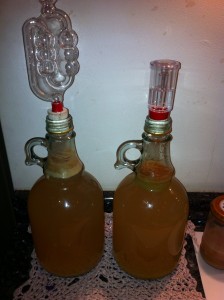

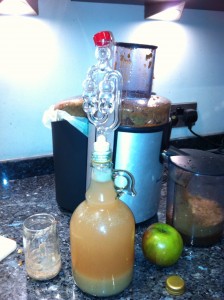
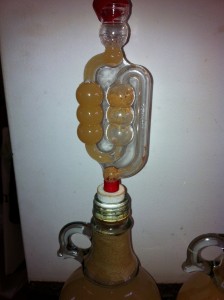
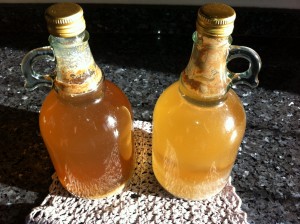
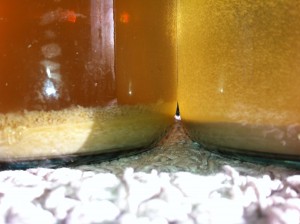
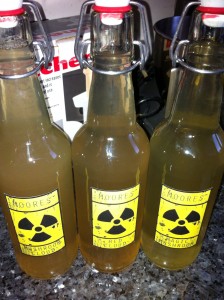
Comments
5 responses to “Sourdough cider”
Another great way to make sure that the sourdough feeding process can be justified ;). Seriously though, the more uses we find for our ferments, the easier it is to integrate all of these cycles into our lives. Nothing like being able to produce your very own distillery out of a simple and humble ferment plucked out of the air 🙂
[…] the last post you saw how Julia Moore used a sourdough levain to start to make cider. Here the circle is […]
Regardless who we talk to – we always learn something.
Very true 🙂
What an interesting post. I’d love to try something like this one day.